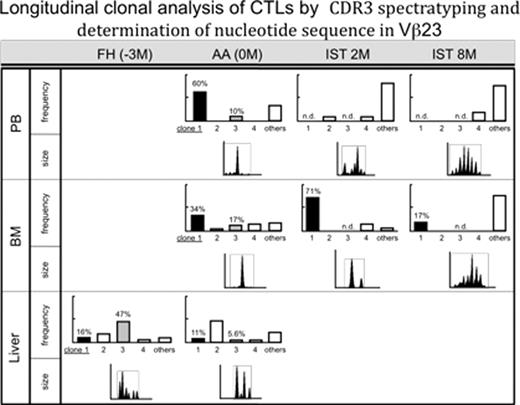Abstract
Abstract 1159
Hepatitis-associated aplastic anemia (HAA) is a variant of acquired aplastic anemia (AA) in which an episode of hepatitis precedes AA, namely hepatitis/aplastic anemia syndrome (HAAS). In AA, cytotoxic T-lymphocytes (CTL) play a central role in bone marrow (BM) destruction, and oligoclonal expansion of CTL correlates with disease activity. Immune mediated mechanisms have also been postulated in the pathogenesis of fulminant hepatitis (FH). Therefore we hypothesized that common CTLs recognizing similar target antigens against both liver and BM cells exist during the early period of FH, and subsequently selective proliferation of clones that are highly tropic to BM cause HAA at later stages. To this end, T cell phenotypes infiltrating liver, BM and peripheral blood (PB) samples obtained from 1-year-old boy with HAAS over time were determined by complementarity-determing region 3 (CDR3) size distribution patterns by polymerase chain reaction. Subsequently, CDR3 nucleotide sequences of predominant products were determined. Extremely skewed pattern was observed in Vb23 in BM and PB specimens at the onset of HAA (3 months after FH). A Vb23 clone with identical CDR3 nucleotide sequence predominated (clone 1) in BM and PB (34% and 60% within Vb23, respectively). This clone constituted a minor, but definitive clone in liver at the onset of FH (16% within Vb23). In contrast, initially predominant clones in liver (clone 3; 47% within Vb23) contracted to a minor subpopulation in BM and PB when the patient developed HAA (17% and 10% within Vb23, respectively).
This patient had a very good response to immunosuppressive therapy (IST) using antithymocyte globulin, cyclosporine, and granulocyte-colony stimulating factor. Two months after starting IST, the pattern of CDR3 size distribution was just recovering to normal and initially predominant clones in both liver and BM almost disappeared in Vb23 in PB. However, extremely skewed pattern of CDR3 region was still observed and abnormal clone 1 had still occupied 71% within Vb23 in BM. As of 8 months after starting IST, CDR3 size distribution recovered to normal patterns (Gaussian distribution) and CTL clones against both liver and BM almost disappeared in both BM and PB. These suggest that it would take a relatively long time to recover immunological parameters completely even in IST good responders.
In conclusion, our data is the first report to suggest that oligoclonal CTL clones simultaneously directed against liver and BM are involved in the pathogenesis of HAAS.
No relevant conflicts of interest to declare.
Author notes
Asterisk with author names denotes non-ASH members.


This feature is available to Subscribers Only
Sign In or Create an Account Close Modal